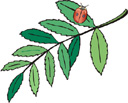
Rowan is a tree. Rowan is called mountain ash, but even though the leaves look similar, the rowan is not a true ash. Rowan is closely related to rose and to a lesser degree related to apple, hawthorne, and pear.
- botanical information
- origin
- nutritional information
- astrological correspondences
- magick correspondences and uses
- ritual uses
- ancient myths and beliefs
- Goddesses and deities
botanical information:
Botanical name: Sorbus acuparia
Common name: Lady of the Mountains, mountain ash, quickbeam, rowan, wildwood
Use the botanical name when ordering seeds (bulbs, etc.) or when looking up information in the library. Common names vary by nation, culture, and region, and sometimes the same common name is applied to different plants.
origin:
Origin: Rowan is originally from northern Europe’s deciduous forests, moors, heaths, and rocky mountain slopes.
Rowan has a shiny grey or grey-ish brown bark. Rowan flowers are creamy white. Rowan berries are small and gree, ripening into bright orange-red berries. Rowan can grow up to 30 feeet tall and to altitudes up to 3,250 feet.
nutritional information:
Rowan’s bright red berries are used to make jelly. Rowan jelly sweetened with sugar can be used as a substitute for cranberry sauce. Crab apples and rowan berries can be used to make a tart jelly. The ancient Welsh made ale from rowan berries.
Rowan bark and berries were used for herbal mediciations.
Rowan was used for tanning and for making black dye.
astrological correspondences:
In Celtic astrology the sign of Rowan is approximately January 21st to February 17th. Rowan Moon is masculine and called Moon of Vision or the Spirit Moon.
magickal correspondences and uses:
Magickal uses: protection against bad luck, evil, and lightning
Horses and other animals were protected from bewitching by rowan wands.
Magickal substitutions: Rosemary usually may be safely substituted for any herb in magick spells and rituals. Roses may safely be substituted for any flower.
ritual uses:
Nine Woods: Rowan is one of the nine woods traditionally placed in the traditional Celtic Druid balefire.
Nine Woods: Rowan is one of the nine woods traditionally placed in the traditional Wiccan Witchcraft balefire. From one version of the Wiccan Rede: “Rowan is a tree of power; Causing life and magick to flower.”
Ritual uses: Druids used rowan fires and incantations to summon spirits to aid their tribe during upcoming battle.
ancient myths and beliefs:
Rowan was the Celtic tree of life. Celts believed that the first woman was a rowan tree and the first man was an alder tree.
Rowan is called the Whispering Tree, because Celts believed that rowan held secrets.
Celts believed that a sprig of rowan placed over the main entrance of a home would keep out evil. Celts would hang a rowan branch over the threshold of their homes on Imbolc (spring fstival). Many Celts planted rowan around their home for protection from evil.
The Celts believed that rowan helped protect against lightning (hence rowan is sometimes called wildwood or quickbeam).
The Welsh placed rowan in graveyards to scare away demons that might disturb the sleep of the dead. Medieval Christians drove rowan stakes into corpses to prevent ghosts, especially if the person died under unusual or violent circumstances.
The Rowan Moon or Luis (L) Moon is the second month of the Beth-Luis-Nion Celtic (Druidic) calendar, running from January 21 to February 17.
deities associated with rowan:
- Brid (Celtic Goddess)
- Brigid (Celtic Goddess)
Rowan bark and berries were used for herbal mediciations. Rowan is an astringent. Rowan was used to make a gargle.
Some herbs may be poisonious under some conditions. Exercise appropriate care.
Wild gathering: Avoid wild gathering. Some plants are endangered species. Some plants can be toxic just by touch. Even experts can make deadly misidentifications of wild plants. Please grow your own herbs in your own goddess garden.














